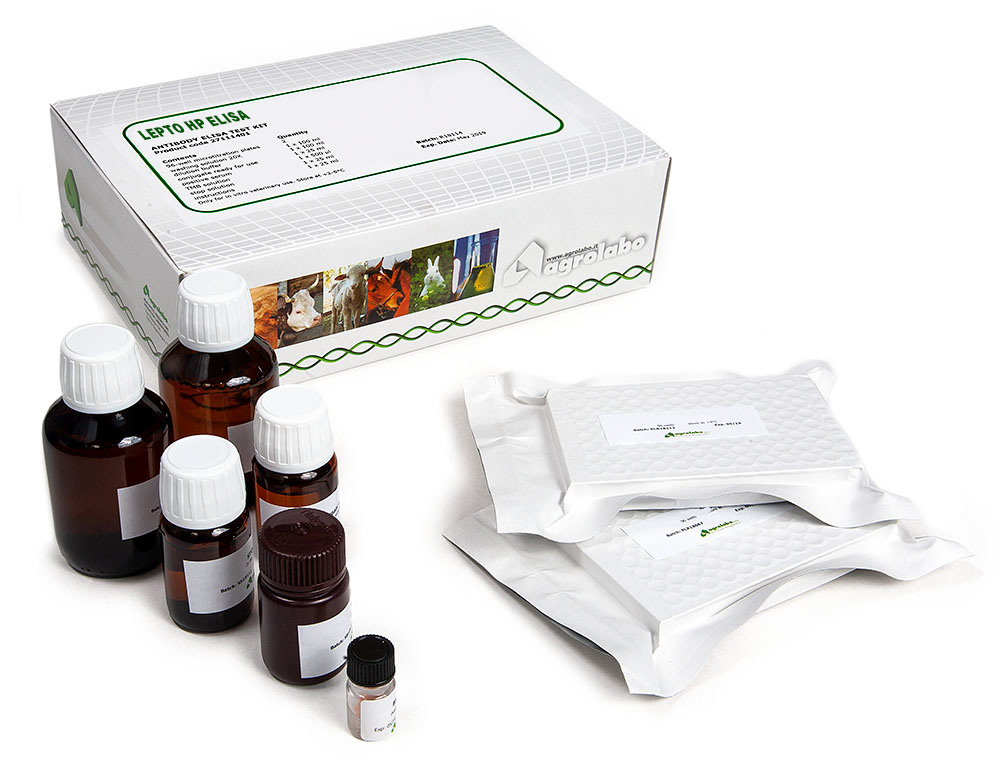Lepto HP ELISA
Immunoenzymatic assay for the detection of antibodies against Leptospira pomona and hardjo in bovine serum.
Leptospirosis is a worldwide zoonotic disease of domestic animals and wildlife. It is caused by a spirochete bacteria classified under the genus Leptospira. The taxonomy of the genus is confusing, with a number of species and serovars. In cattle leptospirosis is primarily due to Leptospira borgpetersenii serovar hardjo (L. hardjo) and Leptospira interrogans serovar pomona (L. pomona). Both serovars may affect cattle of all ages but clinical signs greatly vary depending on the serovar and the age of the animals.
L. pomona may cause acute infections especially in calves. Calves may demonstrate high fever, anorexia, dyspnea, hemolytic anemia, hemoglobinuria, icterus, and high mortalities. Acute infections of naive cattle with L. hardjo are characterized by a sudden drop in milk production. The milk is thick, yellow, and blood-tinged. The udder is typically soft and flabby. L. hardjo causes the milker’s fever syndrome. Moreover both serotypes may cause abortion which generally occurs in late pregnancy. Stillbirths and birth of premature or weak infected calves also occur.
The diagnosis of leptospirosis especially in adult cattle may be difficult. Culture in special media, PCR, immunohistochemistry techniques and serology may be used. Antibody titers may peak before abortion because the acute infection occurred several weeks previously. Abortion due to L. hardjo infections may occur with low or negative serologic titers.
Controls and prepared bovine serum samples are incubated in wells coated with either L. pomona or L. hardjo antigens (Ag). The antibodies (Ab) specific to L. pomona or L. hardjo present in positive serum samples will bind the Ag in the wells. After several washes to eliminate unbound substances, a conjugate (protein G coupled to peroxydase) is added. After incubation, the excess of this conjugate is eliminated by a second series of washes and its attachment to bovine antibodies is revealed with a chromogenous substrate. The conjugate, if present, reacts with the substrate and a blue color develops. The reaction is then stopped and the optical densities are read. The intensity of the color is proportional to the quantity of Ab in the serum samples.
Materials Provided
- 1 x 12 strips of 8 wells coated with L. pomona
- 1 x 12 strips of 8 wells coated with L. hardjo
- 1 x 2,5 ml Ready-to-use positive control
- 1 x 2,5 ml Ready-to-use negative control
- 2 x 100 ml Concentrated wash solution (10X)
- 1 x 500-1000 ul Concentrated conjugate
- 1 x 25 ml Ready-to-use substrate
- 1 x 25 ml Ready-to-use stop solution
.
Material Required but not Provided:
- Purified water
- Adjustable single- and multi-channel micropipettes
- Single use micropipettes tips
- ELISA microplate washer (facultative)
- Test tubes for sample dilution
- ELISA 96-well microplate reader equipped with 450 nm filter
- Containers for preparation of solutions
